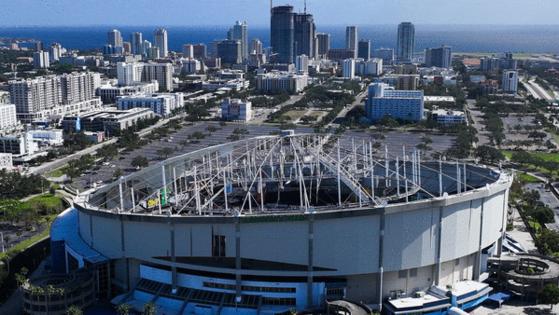St. Petersburg council votes to start Tropicana Field repairs, then changes its mind
Published in Baseball
ST. PETERSBURG, Fla. — Two hours after voting to spend about $24 million to start repairing hurricane-damaged Tropicana Field by replacing the ballpark’s roof, the St. Petersburg City Council on Thursday voted a second time and decided to halt that plan.
The rare action added to the uncertainty over where the Rays will play starting in 2026 amid larger issues that have placed their long-term future in the Tampa Bay area in question.
The city was hoping that with the new roof, and additional repairs currently estimated at about $26.5 million (in addition to $6.5 million already spent to protect the stadium from further damage), the Rays would be able to return to Tropicana Field in time for the 2026 season.
The initial 4-3 vote was taken amid dissent and doubt, including from the Rays, that the project can be completed on time and at that cost.
Copley Gerdes, Brandi Gabbard, Gina Driscoll and Deborah Figgs-Sanders voted for the spending; Lisset Hanewicz, John Muhammad and Richie Floyd voted against it.
But after a vote to delay finalizing bonds for the planned but now in jeopardy new stadium, Gabbard brought up revisiting the Trop repair vote, and it was reversed unanimously. City Administrator Rob Gerdes said city staff was good with that plan, as it would allow time to get further information on the full repair plan.
Council members who initially voted to start the repairs said they did so to remain in compliance with the lease agreement that requires the city to provide the team a suitable facility to play its home games. The agreement runs through 2027, and because the Rays won’t play there in 2025 it can be extended through 2028.
“I just don’t see any other path that is legally responsible for us at this point,” Gabbard said.
Rays president Brian Auld, who attended the meeting, said after the first vote that the Rays are skeptical about the planned repairs being completed on time, which would be more problematic for the team than not making the repairs.
“I would say that the challenge of being ready for 2026 is enormous. ... “ Auld said. “So we in all likelihood are going to have to plan for ‘26 somewhere, in addition to hoping that the city can get Tropicana Field up and ready. That said, as was said on the dais a number of times, our staff will work as hard as we can to partner with the city to get it ready to mitigate damages.”
Auld said the team would “have more certainty” working out a deal with the city, such as a settlement check, than dealing with the additional uncertainty of the repair plan.
“Our certainty is actually greater if the decision is made not to repair Tropicana Field, because I don’t believe we’re going to have a firm answer on whether it can be done for a very long time,” Auld said. “Based on the conversations we’ve had with our engineers, I believe we’re looking at a ‘26 situation where the city is trying to have the stadium ready, and we have to make alternative plans, and all the costs that come with that, that is actually more problematic for us. That’s why we’ve been working on trying to get to a settlement.”
The initial resolution approved by the council would have provided for the city to authorize an agreement between it and Hennessy Construction Services to start the project.
The city was to borrow money from four other funds to provide $23.73 million to the General Capital Improvement Fund to cover the costs of the roof repairs. That included loans of $10 million from the fund for workers compensation, $7.5 million from parking revenues, $5 million from the Equipment Replacement Fund (5002) and $1.230 million from technology and infrastructure.
City staff said the total would fall within the city’s insurance coverage.
The Trop was left unplayable for 2025 after Hurricane Milton roared through St. Petersburg on Oct. 9, shredding the 6-acre Teflon-coated fiberglass roof and causing other extensive damage throughout the stadium, which opened in 1990.
The city, which is responsible for the repairs, released a report on Nov. 12 saying the stadium was structurally sound and repairable, but it would cost about $56 million and take until just before the start of the 2026 season to do so. The Rays will play the 2025 season at Steinbrenner Field in Tampa, spring home of the Yankees.
One major question was whether it was worth repairing the Trop given its short remaining life.
The Rays planned to play there through 2027 then move into a new stadium to be built on an adjacent site.
But the impact of the hurricane changed that plan in several ways.
Because the Rays won’t be able to use Tropicana Field in 2025, a clause in the original agreement provides for their lease to be extended for any missed season, so it would now run through 2028.
More importantly, the new stadium project appears very much in jeopardy after the Pinellas County Commission delayed a vote on approving bonds to finance its share of the $1.3 billion cost.
The Rays now say the stadium couldn’t be completed until 2029 and will cost prohibitively more, enough that the current deal no longer works as they are responsible for cost overruns. Auld said Thursday they want to stay in Tampa Bay and are open to any ideas to make it work.
The 412-page Trop damage report, which includes preliminary prices on some areas of repair, estimates that Hurricane Milton caused $39 million in damage and an additional $16 million in costs such as design, permitting, insurance, inspection, staffing and construction contingencies. The roof is the most costly item.
Noting the city was obligated under the original 30-year use agreement to provide the Rays a place to play, St. Petersburg Mayor Ken Welch said on Nov. 12 that the report yielded “a best-case scenario for us” and wanted the City Council to vote to proceed with the repairs.
He also said the city anticipated that “the majority of the repair costs incurred by the City will be covered by insurance and FEMA reimbursements, making this approach both beneficial for community spirit and fiscally responsible for our community.”
Some of the assessments, such as of the electrical system, were made by a visual inspection and will require component testing, so the total price could be higher, potentially substantially. Also not included was the cost of an acoustical roof membrane, which enhances sound quality during events.
The $55.7 million figure includes about $6.5 million the City Council approved on Oct. 31 to remove the remnants of the roof and damaged turf, and to protect against further damage by waterproofing areas of the stadium that became exposed. The stadium was built as an indoor facility with no drainage system, so the team could not play there without a roof.
As the landlord, the city is responsible for repairs to the stadium and already has filed an insurance claim. The city policy includes a $22 million deductible and $25 million of coverage — reduced in March from $100 million so the city could save $275,000 in premium payments.
©2024 Tampa Bay Times. Visit tampabay.com. Distributed by Tribune Content Agency, LLC.







Comments